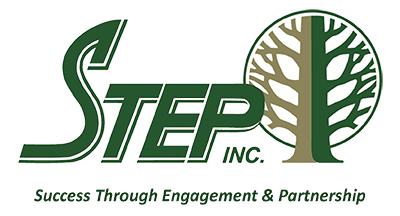If you are the parent of young children living in Lycoming, Clinton or Tioga counties, you probably have known about the childcare desert that exists in those communities and may have even had to deal with the scarcity of childcare options.
Now, a new and innovative staffing program developed by STEP, Inc., called the Substitute Aide Pool program, is seeking to sustain and encourage growth in that desert.
The program is kind of like a temp service for child care workers or individuals that are working in the early care and education setting, according to Rachelle Abbott, STEP’s director.
STEP worked with the Lycoming Planning office to obtain funds through the American Rescue Plan Act for the program.
“We have like a catch-all approach to what we can do to affect the child care crisis,” Abbott said.
The substitute pool is one of those pieces.
Although they were under the impression that similar programs were happening in other places, that was not the case.
“Coming into it, we thought we’d have some models and kind of an idea of how this is working in other areas. We learned very fast that no one in the state is doing this at the level we were looking to,” said Meghann McBryan, special project coordinator, who had been brought on board to implement the program.
“I talked to smaller projects who kind of do it like an email chain in their area, like hey I have extra staff if there’s a facility that needs some help, they’ll just email me…I have staff. That’s the extent of what we found. Nothing to this scale in the state when we did the research,” McBryan said.
So, they were faced with starting from scratch.
“One of the first things I did is get a lot of input from providers in our area-meeting with them and understanding what they’re dealing with staff-wise,” McBryan said.
And that’s how the program was created.
“The premise is basically. We wanted to ensure that these folks were getting paid a wage that they could live on. Here at STEP we have a salary equity scale. Basically that’s how we look at all of our job positions based on various pieces of the job positions,” Abbott said.
“The individuals who are the Substitute Aide Program staff are actually paid the same as our substitute classroom aides at Head Start. There’s equity there in terms of the same work that they are doing,” Abbott explained.
That rate is around $15 an hour, higher than what many childcare facilities pay, which was why initially, there was some pushback from a lot of facilities for the program.
“We just kept forward with the fact that we need quality individuals that are going to be able to be committed to this flexible program,” Abbott said.
The idea was that a substitute aide could be at a facility in Muncy one day and the next they could be in Jersey Shore. Plus the aides might know that they are needed somewhere only an hour or two before they have to be there.
‘It’s very different from going every day to the same center, so we needed to make sure that we were paying people for that kind of different style of employment,” Abbott said.
The program functions through a scheduling software system called Connecteam. It was designed for restaurants which have multiple locations to schedule workers across their different sites.
“We kind of knew that was the point of this program. We have to be able to schedule people at multiple locations and give everyone access to it-this does that,” McBryan said.
Additionally it allows for continual training of aides through online modules. It provides a means of communicating between McBryan and the aides or the childcare centers and between the centers and the aides. Providers can also communicate with each other through the program.
“It also allows us to hold a lot of information. You know, typically when you’re an employee at a business, you know your HR department has your file…this is a fully remote position for our aides, they don’t work in our building,” McBryan said.
A big part of working in the childcare field is the certifications needed, so that was basically “square one” of the program, she said.
“If we are telling these providers to trust us – we’re hiring these people, they don’t hire them, they don’t know them coming into it…We wanted to make sure that we were doing the right things to ensure that anyone that walks in their building is able to work with children,” McBryan said.
As part of the onboarding process, STEP helps the aides obtain all the necessary clearances and training, such as CPR, mandated reporter and anything else the state requires for people seeking to work with children. The Connecteam software system allows STEP to house all that in it as well.
“So, if we have an aide in a facility somewhere and the state walks in and wants to see that everything’s up to par, they can download that employee’s information right on the spot, have everything they need,” McBryan said.
Abbott compared it to a dating app which offers clients potential matches.
The aides put all of their information in. There are bios on the site and videos so that providers can meet the aides before they come to their facility.
“All of our providers can house their policies, procedures, handbooks, everything in the system so that aides can review all of that before they ever go into a facility,” McBryan said.
The technology was a huge part of the program.
Basically how it works is if a provider has a vacant shift they have a schedule dedicated to them in the system. They go in, post the shift and once they do that, any aide in the pool gets an alert on an app on their phone telling them about the vacant shift and asking if they can work it.
“If an aide has an interest in working that shift, they put in a request for it and then all of our providers have the final say of who comes into their facility,” McBryan said.
“That is one way that we were able to build that trust with providers-we’re not just placing these aides in your facility, you choose who comes in,” she added.
At this point, because of the technology, the program is almost running itself, she admitted. Relationships between the aides and the providers have been built so that if a facility needs someone in the future they can ask an aide if they want to fill that time slot.
“It’s a lot of relationship building in this program, I’ve noticed. Which was an outcome that I didn’t see at the beginning, but we’re seeing it become more and more through the program and I think the technology is what allows that to happen. They’re having a lot more communication directly with them,” she said.
The aides work up to 20 hours per week. They receive an hourly wage and a 5 percent retirement match from STEP. Because they are considered part-time workers, they receive no other benefits.
The decision to keep it at 20 hours was made in order to keep the program from pulling staffing from the facilities, which was one of the pushbacks from the childcare owners when the program was being introduced. Because the aides in the substitute pool are being paid higher wages than most facilities pay, there was a fear that the program would entice full-time employees away.
“By limiting the hours, that was kind of a way for us to alleviate that for providers. Like we’re not looking to make the process worse. We’re looking to help you as much as we can,” McBryan said.
The program launched last fall with three aides that came in through the first recruiting cycle.
Within two weeks, because they were already having full week schedules being posted, the shifts came flooding in, McBryan said.
“We’re like, alright. Our aides did great. When you see some of the data and stats of what they were able to accomplish, just the three of them there they were able to cover a lot of shifts, which was great. But, then as we added providers and started seeing that being consistent week after week, we recruited again,” she said.
At the beginning of this month they had five active aides and one going through the onboarding process. McBryan is pushing for another recruitment in hopes of adding two to three more aides. At that time, there were 118 shifts posted.
“It’s a weird balance act because as we add more providers we kind of go through recruitment cycles to balance it out,” she said.
Currently they have nine facilities utilizing the program. That can be any childcare provider such as after and before school care providers. Any licensed center can be part of the program. Enrolling in the program is free and as a sign-on incentive, the centers receive their first 20 hours of usage free. After that they pay a fee for hours used.
The program has been averaging about 30 vacancies per month from the time it began in October, with 91 of them being filled. That’s a 77 percent fill rate, Abbott said.
“So, the aides are keeping classrooms open,” she said.
“I’m going to say this loud and clear-childcare and early care and education is economic development,” Abbott said.
“If we cannot keep the kiddos in a place where they are safe and learning, parents can’t go to work. It’s a cycle,” she said.
The reality is that some facilities have closed and others are having trouble operating at full capacity because of staffing. There are huge waitlists, some for over a year, because so many slots have been lost.
“If we can keep one room open for one day that is a lot. It’s huge for the families,” said Melissa Kerschner, Program Director, Early Learning Resource Center Region 7.


